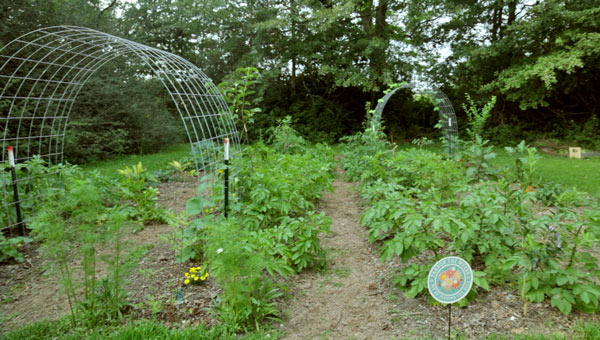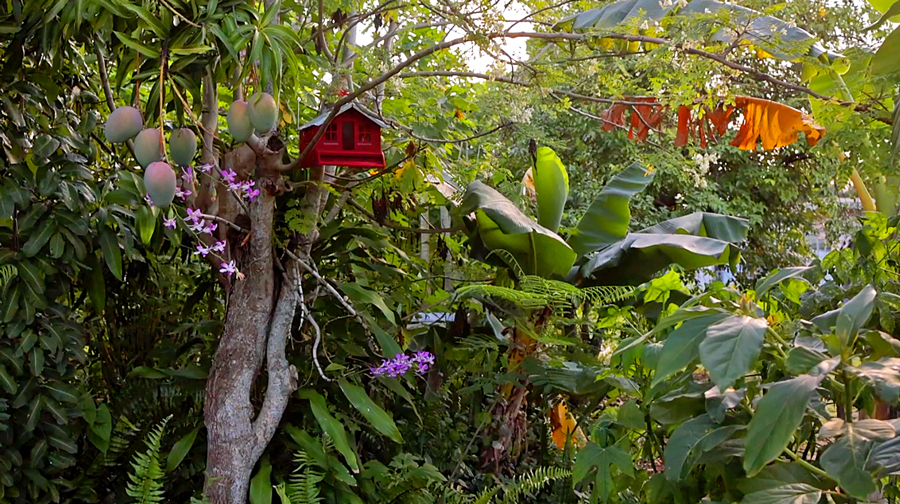A food forest is a long-term proposition, generally taking a few years to really get kicking.
We posted this video on “How to Start a Food Forest the Easy Way” at the end of July and since then it’s gotten a lot of response.
This morning I saw a comment which read:
“Hi David I understand your principles. But can you elaborate on how long it will take before the food forest will provide enough supply of vegetables for one person. Thanks.”

This sounds simple, but is in reality a very complicated question.
First of all, what climate are you growing in? A cold temperate climate food forest has a much shorter growing season than a tropical or subtropical food forest, and the selection of vegetables available will vary.
Secondly, how much time are you willing to invest? If you were to pour yourself into gardening, you could make beds all over a new food forest and simply grow vegetables like you would in any garden. If you planted even a tenth acre of vegetables at the beginning and tended them well, your kitchen would be overflowing in a few months. Unless you mean to provide all the calories for a single person, in which case you would need more space to grow an abundance of storable root, grains and winter squash along with your green vegetables. Potatoes, sweet potatoes, long-keeping pumpkins and squash, grain corn, dry beans, rutabagas and other crops would be key. And I would highly recommend adding a pig pen plus ducks, chickens or both so you have animal foods as well.
Thirdly, what type of soil do you have? If you have rich soil, growing an abundance is easy without spending much time improving the soil. If your soil is poor, you might have to spend a year or more improving the land so it will grow you lots of food. Cover cropping, bringing in mulch and manure, double-digging, making compost piles, gathering fall leaves and sheet-mulching – there are multiple things you may do to improve the ground, but all of them take time and effort.
Fourthly, what type of ecosystem are you starting with? If you’re eliminating grass, you’ll need to till or sheet mulch or meticulously fork and pull weeds. If you’re starting with a patch of brush or woods, you’ll need to eliminate lots of woody material and chop roots to get planting. If you have high rainfall, you may be able to grow with the rain. If you’re in a low rainfall area, you’ll have to find a way to irrigate.
In a tropical climate, we planted pigeon peas and corn, taro and tannia, cassava, sweet potatoes, pumpkin, papaya, melons, bananas, plantains and other fast-producing crops all over our food forest projects. Within a year, we had abundant food. In a temperate climate, our projects usually took a few years to give us abundant food.
Yet if we had gardened in beds through the food forest, we would have plenty more. At the beginning of the 2020 pandemic, we threw ourselves into gardening – often working most of the day on it – and were rewarded quickly with lots of produce. In normal years, however, we lived our lives with gardening as something we mostly did on weekends and in a few minutes here and there, and we reaped accordingly.
The integration of annuals into our food forest systems has generally been secondary to the primary goal of getting the fruits and nuts and shrubs and other perennials rolling.
Which is one reason we developed the Grocery Row Gardening system as outlined in the little book we published in 2021.
The idea was to link the fast production of annuals with the long-term production of tree crops. Thus far, it has been quite successful. It’s not the wild apparently anarchy and flowing lines and vignettes you find in our food forest projects, but it’s quite productive right from the beginning.

But back to the food forest question.
If you wish to quickly produce lots of vegetables in your food forest, simply create lots of annual garden beds around your long-term perennials in the early years so you have plenty of early yields. When your trees are young, they cast very little shade – so take advantage of that window of time to grow all the sun-loving high-yield annuals you can.
Assuming you have some decent soil and a moderately long growing season, along with available water, the main limiting factors will just be your time and will. Put both of them on the task and you’ll have an abundance of food in months, not years.
If a Grocery Row Garden is more your style, we build one from start-to-finish and show results in this video:


6 comments
Hi David
Thank you so much for the detailed explanation and advice.
I am in the process of acquiring land in Hendry county Florida. Presently it’s covered in grass. No significant trees.
It appears to me a market row garden along with simultaneous food forest planting would be the way to go. Would it make sense to disc ploughing the whole area prior to starting because I do not have tree mulch or any significant trees on the property?
Yes, that would make sense. Just be ready to stay on top of the weeds which will come up afterwards.
I’ve learned that I am the biggest limiting factor on how much food I can grow. It’s been embarrassing to see how gardening has revealed my laziness and lack of ability to follow through. When I see a successful gardener, I see a person with some really good character traits.
I feel the same way seasonally. In Spring I feel great seeing everything I’ve grown. By July I’m just looking out at a crispy garden and hoping something might survive the 110° days ahead. And I don’t use irrigation. Still have some Watermelon surviving.
There is much truth to this. Much.
“Will” is a tricky variable, because it builds on itself, and it really drives everything else in the garden. For a beginner gardener, DTG’s Island of Fertility expanding outward to a whole grocery Chain of Islands, or a eventually meshing into a Food Forest….that sounds much more manageable. Few grocery rows and a dozen fruit trees might be a bit overwhelming and very discouraging if there is a series of unfortunate events. I have had more plants go crispy critter this summer, my “experience” just helped to figure out when to pull the dead ones or leave them to decay and feed the survivors….lol.
Comments are closed.